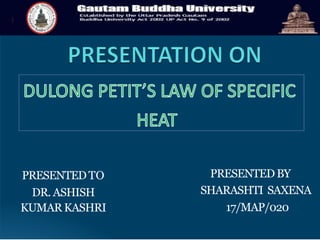Dulong and Petit Law of Specific Heat
•
2 likes•3,043 views
Dulong and Petit Law of Specific Heat in solids.
Report
Share
Report
Share
Download to read offline

Recommended
Recommended
Entropic Equation of the Condition of Simple Crystal Material by Viktor Ivlev* in Crimson Publishers: Peer Reviewed Material Science JournalsEntropic Equation of the Condition of Simple Crystal Material-Crimson Publishers

Entropic Equation of the Condition of Simple Crystal Material-Crimson PublishersCrimsonPublishersRDMS
More Related Content
What's hot
What's hot (20)
Similar to Dulong and Petit Law of Specific Heat
Entropic Equation of the Condition of Simple Crystal Material by Viktor Ivlev* in Crimson Publishers: Peer Reviewed Material Science JournalsEntropic Equation of the Condition of Simple Crystal Material-Crimson Publishers

Entropic Equation of the Condition of Simple Crystal Material-Crimson PublishersCrimsonPublishersRDMS
Similar to Dulong and Petit Law of Specific Heat (20)
Entropic Equation of the Condition of Simple Crystal Material-Crimson Publishers

Entropic Equation of the Condition of Simple Crystal Material-Crimson Publishers
MASSIVE PHOTON HYPOTHESIS OPENS DOORS TO NEW FIELDS OF RESEARCH

MASSIVE PHOTON HYPOTHESIS OPENS DOORS TO NEW FIELDS OF RESEARCH
Thermodynamic Principal #chemical engineering microproject 

Thermodynamic Principal #chemical engineering microproject
Chapter 13 temperature kinetic theory and the gas laws

Chapter 13 temperature kinetic theory and the gas laws
Ivanolegov thermodynamics serbian 4th edition test bank 1

Ivanolegov thermodynamics serbian 4th edition test bank 1
Fundamental principle of information to-energy conversion.

Fundamental principle of information to-energy conversion.
More from Anuj012
More from Anuj012 (6)
optical properties of dimer of plasmonic nanosphere

optical properties of dimer of plasmonic nanosphere
Recently uploaded
Recently uploaded (20)
FAIRSpectra - Enabling the FAIRification of Analytical Science

FAIRSpectra - Enabling the FAIRification of Analytical Science
Porella : features, morphology, anatomy, reproduction etc.

Porella : features, morphology, anatomy, reproduction etc.
Cot curve, melting temperature, unique and repetitive DNA

Cot curve, melting temperature, unique and repetitive DNA
Biogenic Sulfur Gases as Biosignatures on Temperate Sub-Neptune Waterworlds

Biogenic Sulfur Gases as Biosignatures on Temperate Sub-Neptune Waterworlds
FAIRSpectra - Enabling the FAIRification of Spectroscopy and Spectrometry

FAIRSpectra - Enabling the FAIRification of Spectroscopy and Spectrometry
Genetics and epigenetics of ADHD and comorbid conditions

Genetics and epigenetics of ADHD and comorbid conditions
development of diagnostic enzyme assay to detect leuser virus

development of diagnostic enzyme assay to detect leuser virus
Asymmetry in the atmosphere of the ultra-hot Jupiter WASP-76 b

Asymmetry in the atmosphere of the ultra-hot Jupiter WASP-76 b
GBSN - Microbiology (Unit 3)Defense Mechanism of the body 

GBSN - Microbiology (Unit 3)Defense Mechanism of the body
Kanchipuram Escorts 🥰 8617370543 Call Girls Offer VIP Hot Girls

Kanchipuram Escorts 🥰 8617370543 Call Girls Offer VIP Hot Girls
LUNULARIA -features, morphology, anatomy ,reproduction etc.

LUNULARIA -features, morphology, anatomy ,reproduction etc.
Module for Grade 9 for Asynchronous/Distance learning

Module for Grade 9 for Asynchronous/Distance learning
Site specific recombination and transposition.........pdf

Site specific recombination and transposition.........pdf
Dulong and Petit Law of Specific Heat
- 1. PRESENTED BY SHARASHTI SAXENA 17/MAP/020 PRESENTEDTO DR. ASHISH KUMAR KASHRI
- 3. The Dulong–Petit law, a thermodynamic rule proposed in 1819by French physicists Pierre Louis Dulong and Alexis Therese Petit, states the classical expression for the molar specific heat capacity of certain chemical elements. Experimentally the two scientists had found that the heat capacity per weight (the mass-specific heat capacity) for a number of elements was close to a constant value, after it had been multiplied by a number representing the presumed relative atomic weight of the element.These atomic weights had shortly before been suggested by Dalton
- 4. In modern terms, Dulong and Petit found that the heat capacity of a mole of many solid elements is about 3R,where Ris the modern constant called the universal gas constant. Dulong and Petit wereunaware of the relationship with R,since this constant had not yet been defined from the later kinetic theory of gases. The value of 3Ris about 25joules per kelvin, and Dulong and Petit essentially found that this was the heat capacity of certain solid elements, per mole of atoms they contained
- 5. The modern theory of the heat capacity of solids states that it is due to lattice vibrations in the solid, and was first derived in crude form from this assumption by Albert Einstein, in 1907.The Einstein solid model thus gave for the first time a reason why the Dulong–Petit law should be stated in terms of the classical heat capacities for gases
- 6. An equivalent statement of the Dulong–Petit law in modern terms is that, regardless of the nature of the substance, the specific heat capacity cof a solid element (measured in joule per kelvin per kilogram) is equal to 3R/M, where Ris the gas constant (measured in joule per kelvin per mole) and M is the molar mass (measured in kilogram per mole). Thus, the heat capacity per mole of many elements is3R.
- 7. The initial form of the Dulong–Petit law was: cM = K where c is the specific heat, M the atomic weights accepted in that day,and K is a new constant which we know today is about 3R. In modern terms the mass m divided by atomic weight M gives the number of moles N. m/M = N Therefore, using uppercase C for the total heat capacity, and lowercase c for the specific heat capacity c : (C/m)M = K C(M/m) = C/N = K = 3R or . C/N = 3R Therefore the heat capacity of most solid crystalline substances is 3R per mole of substance
- 9. Despite its simplicity, Dulong–Petit law offers fairly good prediction for the specific heat capacity ofmany elementary solids with relatively simple crystal structure at high temperatures. The Dulong–Petit law fails at room temperatures for light atoms bonded strongly to each other, such as in metallic beryllium, and in carbon asdiamond. In the very low (cryogenic) temperature region, where the quantum mechanical nature of energy storage in all solids manifests itself with larger and larger effect, the law fails for all substances.